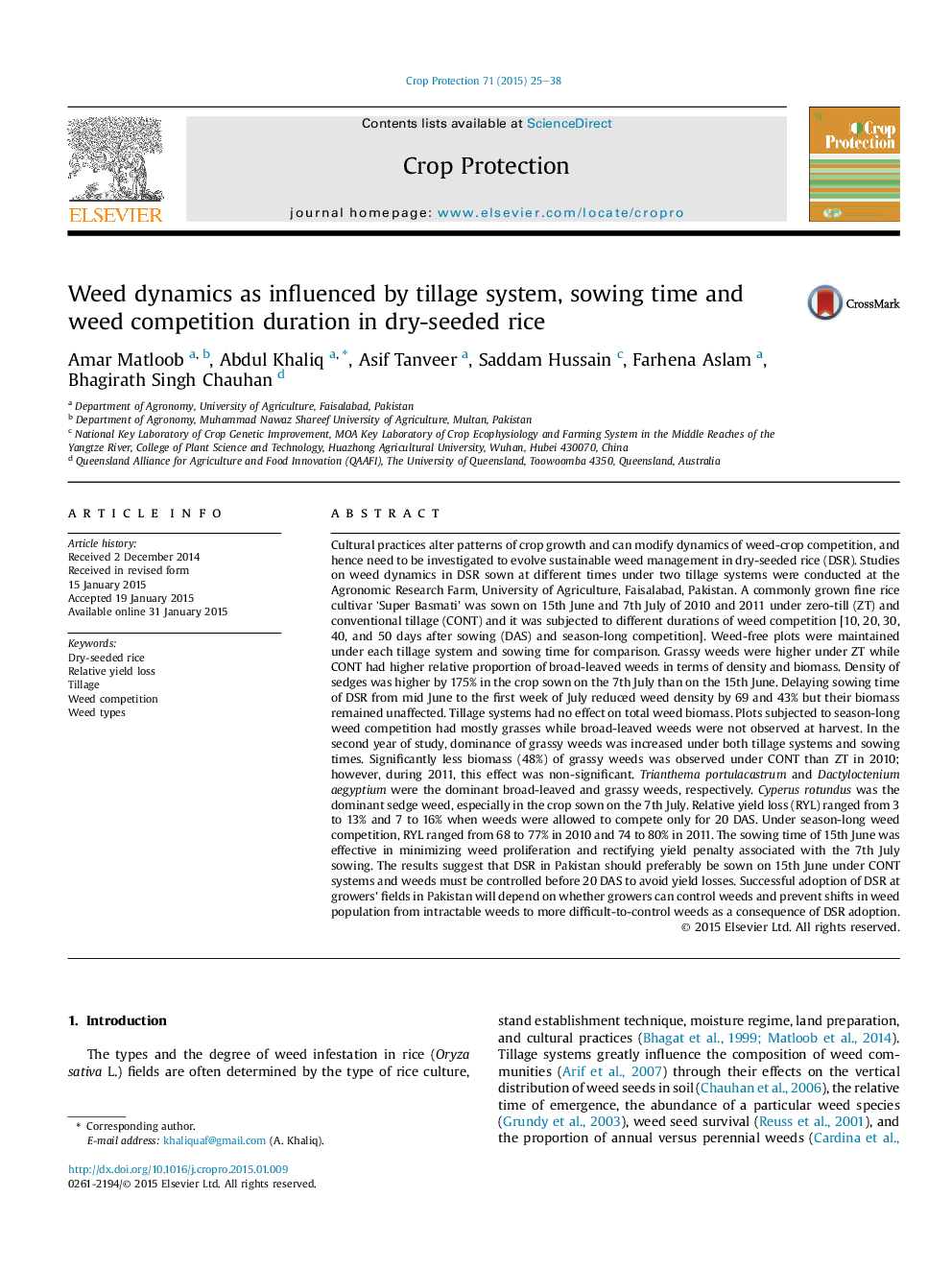| کد مقاله | کد نشریه | سال انتشار | مقاله انگلیسی | نسخه تمام متن |
|---|---|---|---|---|
| 4505709 | 1624316 | 2015 | 14 صفحه PDF | دانلود رایگان |
• Effect of tillage systems, sowing times and weed competition duration was studied on weed growth in dry-seeded rice.
• Grassy weeds were higher under ZT while CONT had higher proportion of broad-leaved weeds in terms of density and biomass.
• Plots subjected to season-long weed competition had mostly grasses while broad-leaved weeds were not observed at harvest.
• Under season-long weed competition, relative grain yield loss ranged from 68 to 77% in 2010 and 74 to 80% in 2011.
• Dry-seeded rice should be sown on 15th June under CONT system and weeds must be controlled within 20 days after sowing.
Cultural practices alter patterns of crop growth and can modify dynamics of weed-crop competition, and hence need to be investigated to evolve sustainable weed management in dry-seeded rice (DSR). Studies on weed dynamics in DSR sown at different times under two tillage systems were conducted at the Agronomic Research Farm, University of Agriculture, Faisalabad, Pakistan. A commonly grown fine rice cultivar ‛Super Basmati’ was sown on 15th June and 7th July of 2010 and 2011 under zero-till (ZT) and conventional tillage (CONT) and it was subjected to different durations of weed competition [10, 20, 30, 40, and 50 days after sowing (DAS) and season-long competition]. Weed-free plots were maintained under each tillage system and sowing time for comparison. Grassy weeds were higher under ZT while CONT had higher relative proportion of broad-leaved weeds in terms of density and biomass. Density of sedges was higher by 175% in the crop sown on the 7th July than on the 15th June. Delaying sowing time of DSR from mid June to the first week of July reduced weed density by 69 and 43% but their biomass remained unaffected. Tillage systems had no effect on total weed biomass. Plots subjected to season-long weed competition had mostly grasses while broad-leaved weeds were not observed at harvest. In the second year of study, dominance of grassy weeds was increased under both tillage systems and sowing times. Significantly less biomass (48%) of grassy weeds was observed under CONT than ZT in 2010; however, during 2011, this effect was non-significant. Trianthema portulacastrum and Dactyloctenium aegyptium were the dominant broad-leaved and grassy weeds, respectively. Cyperus rotundus was the dominant sedge weed, especially in the crop sown on the 7th July. Relative yield loss (RYL) ranged from 3 to 13% and 7 to 16% when weeds were allowed to compete only for 20 DAS. Under season-long weed competition, RYL ranged from 68 to 77% in 2010 and 74 to 80% in 2011. The sowing time of 15th June was effective in minimizing weed proliferation and rectifying yield penalty associated with the 7th July sowing. The results suggest that DSR in Pakistan should preferably be sown on 15th June under CONT systems and weeds must be controlled before 20 DAS to avoid yield losses. Successful adoption of DSR at growers' fields in Pakistan will depend on whether growers can control weeds and prevent shifts in weed population from intractable weeds to more difficult-to-control weeds as a consequence of DSR adoption.
Journal: Crop Protection - Volume 71, May 2015, Pages 25–38
